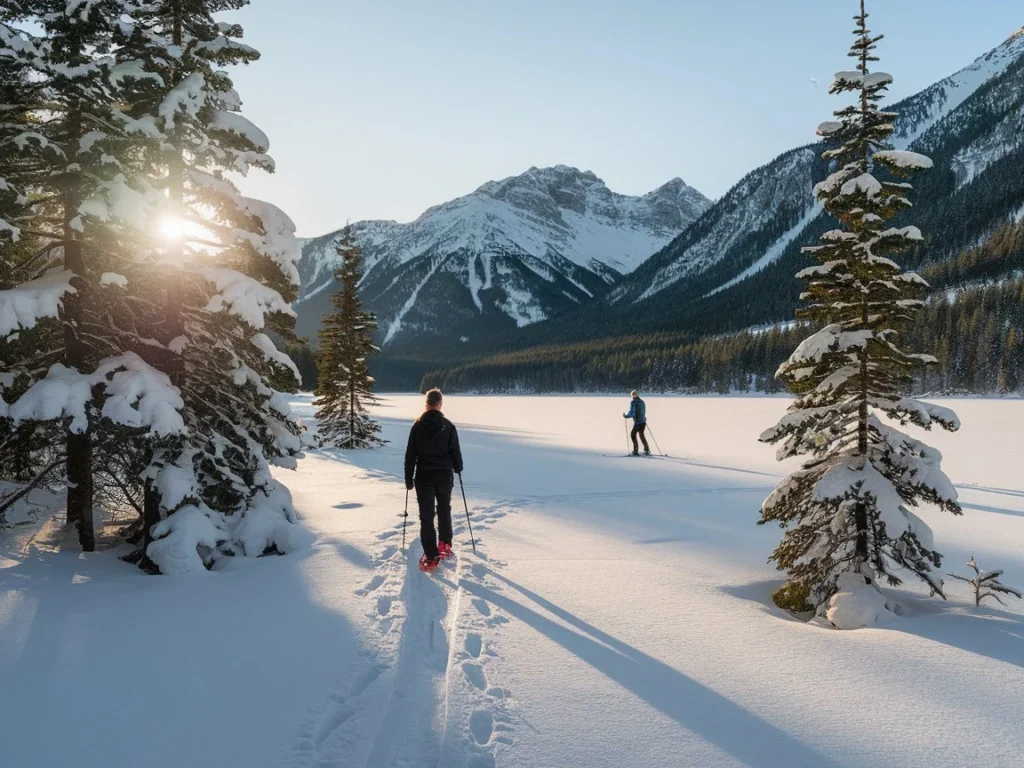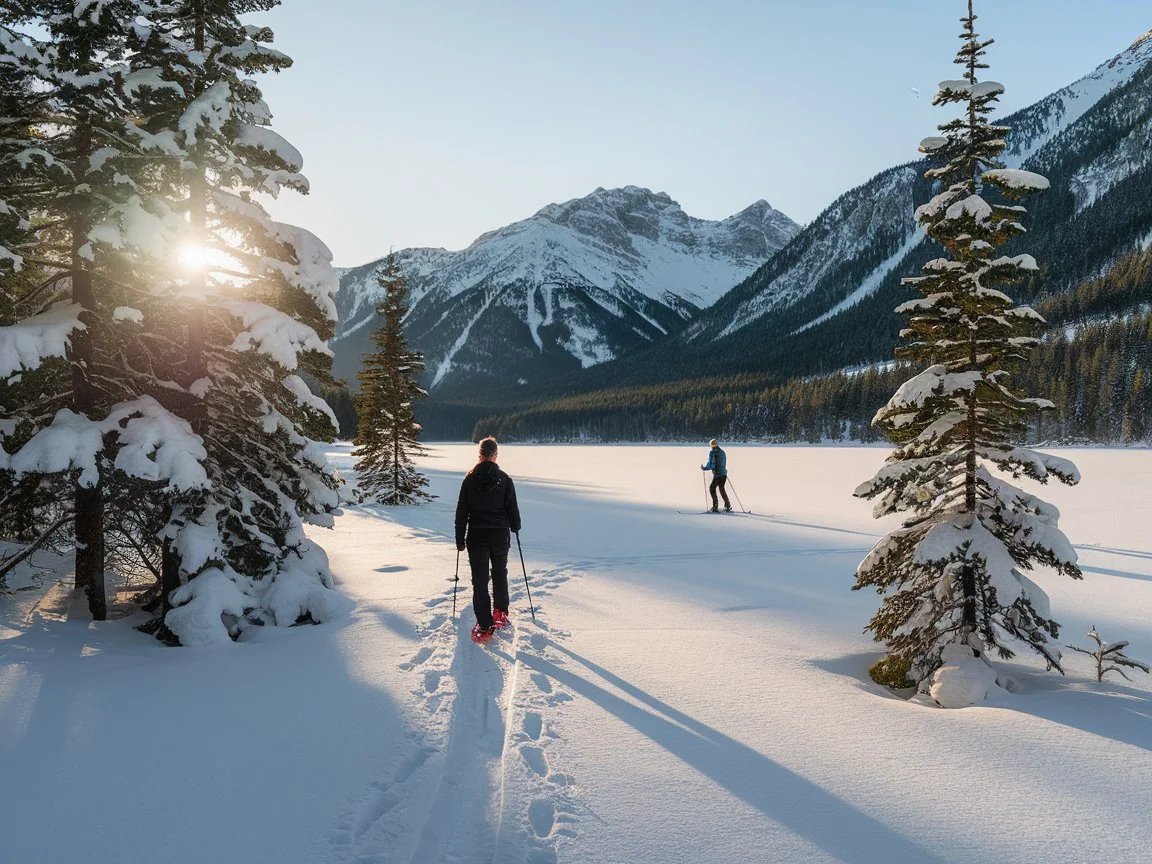
Introduction
Winter transforms the mountains into a snowy wonderland, offering endless opportunities for outdoor adventures. Among the most popular winter activities are snowshoeing and cross-country skiing—two sports that are not only fun but also accessible to people of all skill levels. Whether you’re a seasoned outdoor enthusiast or a beginner looking to try something new, these activities provide a fantastic way to explore the winter landscape.
Snowshoeing and cross-country skiing are low-impact exercises that offer a full-body workout, improving cardiovascular health, building strength, and boosting endurance. They’re also incredibly versatile, allowing you to enjoy everything from serene forest trails to challenging mountain terrains. This guide will help you decide which activity suits you best, highlight the best destinations, and provide tips on gear, techniques, and safety to ensure a memorable winter adventure.
1. Snowshoeing vs. Cross-Country Skiing: Which One is Right for You?
Both snowshoeing and cross-country skiing are excellent winter activities, but they cater to different preferences and skill levels.
- Snowshoeing: Snowshoeing is one of the easiest winter sports to learn. It’s essentially walking on snow with the help of specially designed shoes that distribute your weight, preventing you from sinking into deep snow. It’s perfect for those who enjoy hiking and want to explore off-trail areas. Snowshoeing requires minimal equipment and is ideal for all fitness levels.
- Cross-Country Skiing: Cross-country skiing is more technique-driven and offers a faster way to travel across snowy terrain. It’s a great workout that engages both the upper and lower body. While it has a steeper learning curve, it’s incredibly rewarding once you master the basics. Cross-country skiing is best for those who enjoy a challenge and want to cover more ground.
- Choosing the Best Option: Consider your fitness level, the terrain you’ll be exploring, and your personal preferences. If you’re new to winter sports or prefer a slower pace, start with snowshoeing. If you’re looking for a more dynamic workout and enjoy gliding across the snow, try cross-country skiing.
2. Best Mountain Destinations for Snowshoeing and Cross-Country Skiing
Here are three incredible destinations to experience these winter sports:
- Trail 1: Rocky Mountain National Park, Colorado
- Difficulty Level: Beginner to Intermediate
- Scenic Highlights: Snow-covered peaks, frozen lakes, and abundant wildlife. The Bear Lake Trail is a popular snowshoeing route, while the Hidden Valley area offers groomed cross-country skiing trails.
- Trail 2: Tahoe National Forest, California
- Difficulty Level: Intermediate to Advanced
- Scenic Highlights: Dense pine forests, panoramic views of Lake Tahoe, and challenging backcountry terrain. The Donner Summit area is a favorite for both snowshoeing and cross-country skiing.
- Trail 3: Acadia National Park, Maine
- Difficulty Level: Beginner to Intermediate
- Scenic Highlights: Coastal views, snow-dusted forests, and serene carriage roads perfect for cross-country skiing. The Jordan Pond Path is a great snowshoeing option.
3. Essential Gear for a Safe and Fun Experience
Having the right gear is crucial for a comfortable and safe winter adventure.
- Snowshoes & Skis: Choose snowshoes based on your weight and the type of terrain you’ll be exploring. For cross-country skis, consider classic skis for groomed trails or backcountry skis for off-trail adventures. Ensure they’re the right size and properly fitted.
- Proper Winter Clothing: Dress in layers to regulate body temperature. Start with a moisture-wicking base layer, add an insulating mid-layer, and finish with a waterproof outer layer. Don’t forget warm gloves, a hat, and insulated boots.
- Other Essentials: Poles are essential for both activities, providing balance and support. Carry a backpack with hydration systems, snacks, and an emergency kit that includes a first-aid kit, map, and headlamp.
4. Techniques for Beginners
If you’re new to snowshoeing or cross-country skiing, here are some basic techniques to get started.
- Basic Snowshoeing Techniques:
- Walking: Take slightly wider steps to avoid stepping on the snowshoes.
- Turning: Step one foot out to the side and pivot.
- Inclines: Use the crampons on your snowshoes for traction and lean slightly forward when climbing.
- Cross-Country Skiing Basics:
- Gliding: Push off with one ski while gliding on the other.
- Stopping: Use a snowplow technique by pointing your ski tips together.
- Balance: Keep your weight centered and use poles for stability.
- Common Mistakes: Avoid leaning too far back on snowshoes or skis, which can cause falls. Take your time to practice and build confidence.
5. Safety Tips for Winter Adventures
Winter sports come with unique challenges, so it’s important to stay safe.
- Understanding Weather Conditions: Check the forecast before heading out and be prepared for sudden changes in weather. Avoid venturing out during storms or extreme cold.
- Avalanche Awareness: If you’re exploring backcountry areas, take an avalanche safety course and carry essential gear like a beacon, probe, and shovel.
- Wildlife & Environmental Considerations: Respect wildlife by keeping a safe distance and following Leave No Trace principles. Stay on marked trails to protect the environment.
6. Planning a Winter Cabin Getaway with Snowshoeing & Skiing
A winter cabin getaway is the perfect way to combine snowshoeing and cross-country skiing with relaxation.
- Finding a Rental Cabin: Look for cabins near popular winter trails. Websites like Airbnb and VRBO offer great options with cozy amenities like fireplaces and hot tubs.
- Packing for a Weekend Adventure: Bring warm clothing, gear, and essentials like food, water, and entertainment. Don’t forget a good book or board games for downtime.
- Combining Activities: After a day on the trails, unwind by the fireplace with a cup of hot cocoa or enjoy stargazing on a clear winter night.
Conclusion
Snowshoeing and cross-country skiing are fantastic ways to embrace the winter season and explore the mountains. Whether you’re looking for a peaceful hike through snowy forests or an exhilarating glide across open trails, these activities offer something for everyone. With the right gear, techniques, and safety precautions, you can enjoy a fun and rewarding winter adventure. So bundle up, head to the mountains, and make snowshoeing and cross-country skiing a cherished part of your winter traditions. Happy exploring!
For more you can check our guide on How to Choose the Perfect Mountain Cabin

